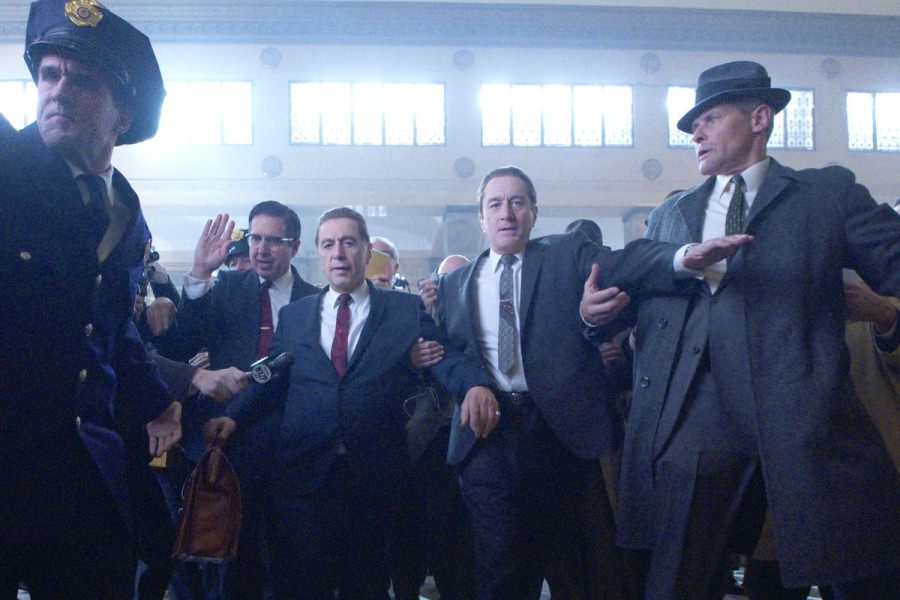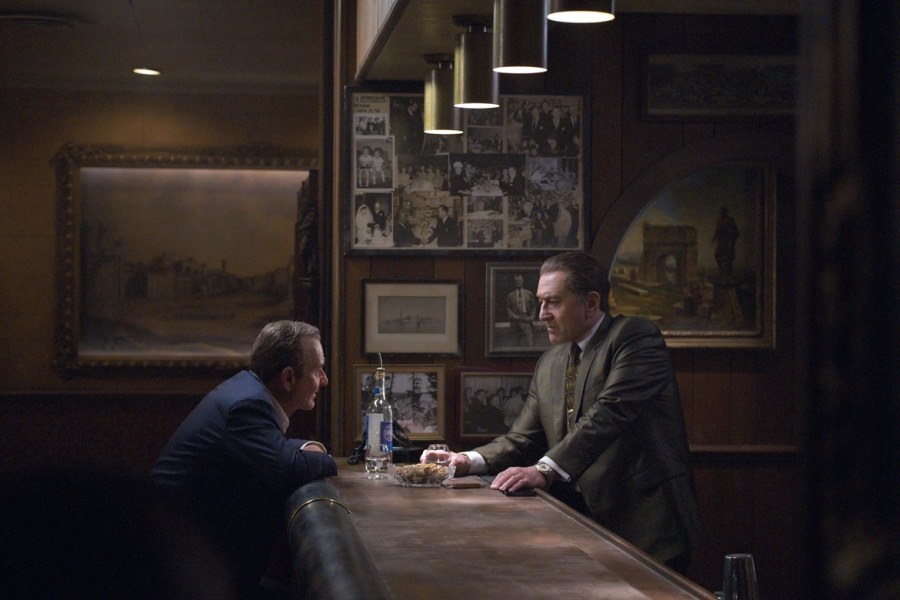The Irishman
Directed by Martin Scorsese (2019) ***
The Irishman feels like the end of an era: the end of Martin Scorsese‘s fifty year-run of gangster-themed films, the possible end of epic-lengthed feature film drama (most narratives of similar stature are now created as TV series or miniseries), and the end, or tail end, of Scorsese’s collaborations with the actors Joe Pesci and Harvey Keitel  (both of whom had to be cajoled out of semi-retirement) and, especially, Robert De Niro (their first collaboration was in 1973).
(both of whom had to be cajoled out of semi-retirement) and, especially, Robert De Niro (their first collaboration was in 1973).
The elegiac production of the film is reflected and carried over into the story itself, a fifty-year long saga about a WWII veteran hitman, Frank Sheeran (De Niro) with divided allegiances. Because the story, based on what is possibly a true tale (from investigator Charles Brandt’s book I Heard You Paint Houses), continues to the year 2000, and follows Sheeran and his fellow mobsters into old age, The Irishman has a different, more wise and mature tone than earlier works like Casino (1995) and Goodfellas (1990), which, while not exactly lauding mobster’s actions, conveyed the braggadocio and swagger of those who considered themselves above the law. The Irishman is both more low-key and realistic, with mobsters attaining old age, fumbling for their daily pills, trying to make amends through family and church, and aware that their lives brought tragedy to others.
The Irishman begins with Sheeran near the end of his life in a nursing home, telling the story of his life. Post WWII, Sheeran worked as a union truck-driver and, through selling stolen steaks to Philadelphia Mafia mobster Skinny Razor (Bobby Cannavale), is defended in court by lawyer Bill Bufalino (Ray Romano). Sheeran eventually meets Bill’s cousin, Russell Bufalino (Joe Pesci), crime boss of the Bufalino family and the head of the Philadelphia Mafia, Angelo Bruno (Harvey Keitel). “I Heard You Paint Houses” was mob code language for saying, “I’ve heard you kill people”, and Sheeran is signed on to work for not only Russell but, eventually, Jimmy Hoffa (Al Pacino), who’s having a longtime fight for power with Teamster “Tony Pro” Provenzano (Stephen Graham, so memorable as Al Capone in the Scorsese-produced Boardwalk Empire).

Though there are scenes of abrupt violence, The Irishman (for better or worse) doesn’t rely on bravura set-pieces as in earlier Scorsese gangster films. The killings portrayed here are often quick, casual, over practically before you realize it; just another assignment in a day’s work. The film also puts an emphasis on literal families apart from the brotherhood of hoods. Sheeran has a strained, and eventually estranged, relationship with one of his daughters, Peggy (Anna Paquin), who realizes the depths of her father’s double life, and refuses to warm up to the grandfatherly Russell. The story of Sheeran’s “career” is inter-cut with a more recent tale of an older Sheeran and Russell, along with their wives, making a road trip to the wedding of Bill’s daughter. Eventually, both stories converge in Sheeran’s nearly co-equal loyalties resulting in a painful dilemma.
The most important thing is, how can I move forward towards something that I can’t articulate, that is new in storytelling with moving images and sound? ~Martin ScorseseIt’s worth noting that The Irishman is 3 1/2 hours long, though so involving it doesn’t feel like it. The somber story propels forward sharply, every detail seemingly true to history and important to the story; the set design and costumes are impeccable. Different color schemes and textures are used for various time periods, giving the audience an almost subliminal reference point for each scene. The acting is restrained and subtle, eschewing the demonstrative outbursts of similar movies. I don’t think Pesci raises his voice once during the entire proceedings. Smaller roles are filled with an array of superior actors: Jesse Plemons as Russell’s foster son, Chuckie O’Brien, Stephanie Kurtzuba as Sheeran’s wife, Irene, and Jack Huston (also of Boardwalk Empire) as Robert F. Kennedy. Because the story requires younger versions of actors now in their ’70s, subtle CGI software developed for the venture was used to “de-age” actors. Though this resulted in some places with a softer image, I didn’t find the results distracting, being caught up in the story, and definitely didn’t think the CGI use was disastrous, as in the “uncanny valley” use of Peter Cushing and Carrie Fisher’s visages in Star Wars: Rogue One (2016).
The Irishman has been released in a physical format by Criterion, in a two-disc set. The second disc, all extras, includes a half hour making of documentary, an analysis of the “text” by film critic Farran Smith Nehme, a feature on the de-aging CGI, an actor’s round-table discussion and much more. One might question whether the film has so quickly attained the stature of “classic” as to be released on The Criterion Collection, but it would most likely be considered as much eventually, anyway.
—Michael R. Neno, 2021 Feb 16
